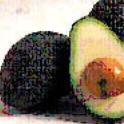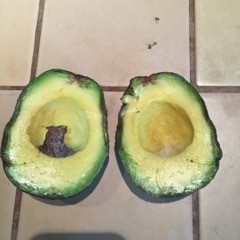
Posts Tagged: avocado fruit
Red Discoloration in My Avocado Flesh
The questions that come in stump many of us, but we often have ways of finding answers. Here's a recent request and Mary Lu Arpaia's response. She's one of our Postharvest Physiologist Specialists.
The Question:
"I am an extension specialist in NH, and I work with (mostly temperate!) fruit/veg crops. A consumer has reached out to the NH Division of Public Health here, with concerns about an avocado they purchased. I'm reaching out to you because you have written some outreach materials relating to avocado, and I suspect that you are much more familiar with this crop than we in New Hampshire are.
Would you have any insights about red discoloration inside an avocado fruit (see attached photo)? It does not look like typical chilling injury to me. Any thoughts would be welcome. Thank you for your time!"
Mary Lu's Response:
"You occasionally see this problem in ripe fruit, especially in lower maturity fruit.
Anyway the best guess is that it is phenolics from the seed coat leaking into the flesh of the fruit.
Not dangerous but the affected flesh may be bitter. I would cut it out and eat around the discolored flesh which is surface only."
Consumers in far away places often will see problems that we in avocado growing regions may never see. Increasingly though, the fruit is grown not so close to home and has traveled long distances, been handled by many different people and treated in less than acceptable fashion. So we may see more fruit problems in California as we import more fruit.

avocado red staining
Eat More Avocados
MISSION VIEJO, Calif. — Tufts University has released results of a study linking eating avocados to helping improve cognitive brain function in older adults, news especially relevant to Hispanics who have been found to have the longest life expectancy rate in the U.S.1 Published in the journal Nutrients and supported by the USDA and the Hass Avocado Board, the research tracked how 40 healthy adults ages 50 and over who ate one fresh avocado a day for six months experienced a 25% increase in lutein levels in their eyes and significantly improved working memory and problem-solving skills.
Lutein is a type of carotenoid antioxidant, or pigment, commonly found in fruits and vegetables already widely accepted to have a role in preserving eye health and now increasingly thought to have a positive impact on brain health as well. As study participants incorporated one medium avocado into their daily diet, researchers monitored gradual growth in the amount of lutein in their eyes and progressive improvement in cognition skills as measured by tests designed to evaluate memory, processing speed and attention levels. In contrast, the control group which did not eat avocados experienced fewer improvements in cognitive health during the study period.
“The results of this study suggest that the monounsaturated fats, fiber, lutein and other bioactives make avocados particularly effective at enriching neural lutein levels, which may provide benefits for not only eye health, but for brain health,” said Elizabeth Johnson, Ph.D., lead investigator of the study from the Jean Mayer USDA Human Nutrition Research Center on Aging, at Tufts University. “Furthermore, the results of this new research reveal that macular pigment density more than doubled in subjects that consumed fresh avocados, compared to a supplement, as evidenced by my previous published research. Thus, a balanced diet that includes fresh avocados may be an effective strategy for cognitive health.”
“Tuft's findings that eating avocados is linked to a positive impact on memory is one more reason to enjoy healthy avocados daily. It's especially good news for Hispanic households where avocados are already so popular and older generations are culturally central to the core family unit,” said Emiliano Escobedo, Executive Director of the Hass Avocado Board. “More research is needed in different populations with different amounts of avocado to better understand the connection between avocados and brain health.”
To view the abstract, visit here.
This study is part of ongoing research that is continually unlocking the unique benefits of avocados to human health. Discover delicious inspiration for different ways to prepare and enjoy healthy avocados in Spanish at SaboreaUnoHoy.com and in English at LoveOneToday.com.
1. Center for Disease Control, April 2016
–The Hass Avocado Board
For Full Article, Click on Download PDF [235 KB, uploaded 23 August 2017]
Avocado Consumption Increases Macular Pigment Density in Older Adults: A Randomized, Controlled Trial
Abstract
Lutein is selectively incorporated into the macula and brain. Lutein levels in the macula (macular pigment; MP) and the brain are related to better cognition. MP density (MPD) is a biomarker of brain lutein. Avocados are a bioavailable source of lutein. This study tests the effects of the intake of avocado on cognition. This was a six-month, randomized, controlled trial. Healthy subjects consumed one avocado (n = 20, 0.5 mg/day lutein, AV) vs. one potato or one cup of chickpeas (n = 20, 0 mg/day lutein, C). Serum lutein, MPD, and cognition were assessed at zero, three, and six months. Primary analyses were conducted according to intent-to-treat principles, with repeated-measures analysis. At six months, AV increased serum lutein levels by 25% from baseline (p = 0.001). C increased by 15% (p = 0.030). At six months, there was an increase in MPD from baseline in AV (p = 0.001) and no increase in C. For both groups, there was an improvement in memory and spatial working memory (p = 0.001; p = 0.032, respectively). For AV only there was improved sustained attention (p = 0.033), and the MPD increase was related to improved working memory and efficiency in approaching a problem (p = 0.036). Dietary recommendations including avocados may be an effective strategy for cognitive health.

avocado fruits
A New Posting of the Topics in Subtropics Newsletter
Here's the Fall newsletter of Topics in Subtropics, and it is on time. Winter hasn't started yet, but get ready.
And the topics are:
- Real-Time Sensor for Early Detection of Citrus Huanglongbing (HLB)
- The 2016 International Citrus Conference
- UC Riverside Scientists Evaluate Trunk Injections of Pesticides for The Management of Ambrosia Beetles in California Avocados
- An Overview of Mango
- Water Based Latex Paint as a Means to Track Ambrosia Beetle Activity on Infested Trees
http://ceventura.ucanr.edu/newsletters/Topics_in_Subtropics66242.pdf
To subscribe:
http://ceventura.ucanr.edu/Com_Ag/Subtropical/

topics

avocado body rot2
Woody Fruit and Other Avocado Abnormalities
Keeping your eyes open in the field can result in some unusual finds. A recent observation that was sent in concerned an avocado fruit which didn't really have the shape of an avocado and certainly not the texture. It is a "woody avocado" as described by Professor Robert Hodgson of UCLA in 1935:
Hodgson, R. W. 1935. Avocado Fruit Abnormalities. California Avocado Association 1935 Yearbook 19: 108-109.
http://www.avocadosource.com/cas_yearbooks/cas_20_1935/cas_1935_pg_108-109.pdf
Dr. Art Schroeder at the same institution pursued it further, still with no clear cause for the condition:
Schroeder, C. A. 1953. Abnormal Fruit Types in the Avocado. California Avocado Society 1953-54 Yearbook. 38:121-124.
http://avocadosource.com/cas_yearbooks/cas_38_1953-54/cas_1953-54_pg_121-124.pdf
Mary Lu Arpaia and Reuben Hofshi revisited the issue of avocado fruit abnormalities in 2002:
Avocado Fruit Abnormalities and Defects Revisited
http://www.avocadosource.com/cas_yearbooks/cas_86_2002/cas_2002_pg_147-162.pdf
It is still not clear what causes this condition, other than it is not transmissible and does not occur very often.

woody avocado 1
When an Avocado is Ripe
The avocado is an amazing fruit. It grows on a tree and comes to maturity, reaches certain oil content and a stage at which it will ripen, but it does not ripen on the tree. It needs to be removed from the tree before it will soften. If the fruit is removed before it has reached maturity it will not soften, and will remain rubbery and inedible. One of the problems is that the fruit will hang on the tree for an extended period of time and it is hard to know when they are mature. Avocados are not like apricots where you have about 2 weeks to get the fruit off before it falls off. As the fruit stays on the tree in gradually develops more and more oil content and has a richer flavor.
If the fruit stays on the tree too long, the oil can develop and almost rancid flavor, however. So it is good to know when the best, acceptable flavor is. Avocado varieties fall into general seasonal periods when they are mature, such as Fuerte' and ‘Bacon” in winter, ‘Hass' in spring/summer, ‘Lamb-Hass' in summer/fall.
To assess maturity, take an unripe stage cut the fruit in half. Look at the seed coat. If the seed coat (the covering of the seed that separates it from the flesh) is white and thick, it is definitely not ready to pick. If it is whitish brown and getting thinner, then if you are desperate, you can try ripening the fruit and taste. If the seed coat is thin and brown, then usually this will mean that the fruit is ready to pick. If the seed has germinated already in the fruit then normally the fruit is over the hill. Some green skin varieties skin will begin to crack when the fruit are very mature on the tree. This will tell you when you have reached the end of the useful tree life of the fruit.
For ripening, pick the fruit and without any help, the fruit will typically be ripe in 7 to 10 days. If you want to speed things along a bit you can take 3 or 4 avocados and place them in a loosely closed paper bag with 2 – 3 Red or Golden Delicious apples or ripe kiwifruit. The purpose of the apples or kiwifruit is that these fruit produce a natural plant hormone, ethylene that will help stimulate the avocado to produce its own ethylene. Apples and kiwifruit are known to produce lots of ethylene. The Delicious apples are varieties that produce more ethylene than other apple varieties. You can keep them even after they are shriveled and they will be producing ethylene. Don't use a plastic bag unless you keep it opened since the fruit need to breathe during this process. Just keep the fruit on your kitchen counter or in a warm place. 68F is the ideal temperature. Lower and higher temperatures both actually slow the process.

hass half
